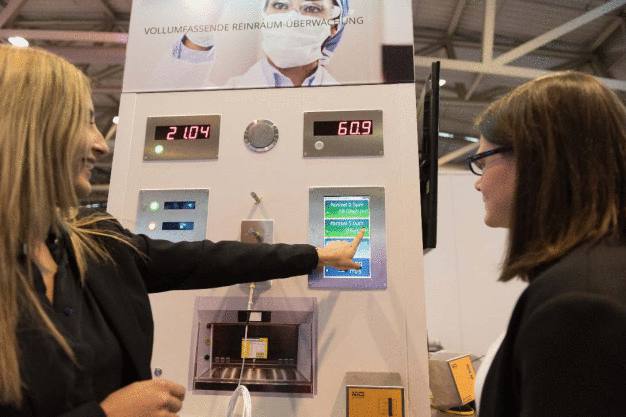- Trade fair
Access control, monitoring and traceable products – safety first!
Cleanrooms = Safety in its purest form This includes rules governing personal access and the items taken into cleanrooms, as well as the prevention of counterfeit products. A key principle underlies all such efforts: Tracking. Current possibilities in this field will be on display for visitors to the cleanroom trade fair Cleanzone on Tuesday and Wednesday, 23 and 24 October 2018, in Frankfurt am Main.
Cleanrooms are classified according to the threshold values for particulate and micro-biological contamination, yet the interfaces between cleanrooms and the ‘impure’ areas surrounding them, as well as between various cleanroom zones, are especially sensitive. This is where airlocks have an important role to play. It must be possible to strictly define those who enter and exit here, and this process must be traceable.
Access control and traceability of objects
There are various ways in which to control access, with examples including decentralised systems with control elements located directly on the doors, and central systems in which the doors are equipped with simple operating terminals. These can take the form of touch displays or even RFID systems incorporating touch-free employee identification. In the latter case, it is particularly easy to modify individual access authorisations or implement specific restrictions. For example: Only a certain number of people can be working in Zone X simultaneously, and these people must comprise defined and practised teams.
One of the challenges here involves the ability to trace which employee took a particular implement into and/or out of the cleanroom (e.g. shoes, overalls, caps, mops, wiping cloths).
Currently, one of the basic measures being used for this purpose involves ensuring that each employee is only provided with precisely what they require each day – nothing more and nothing less. Once work has finished, the items of clothing and equipment are then placed in specific compartments or cupboards, from where they are picked up for cleaning and/or decontamination. This can be done by the cleanroom operator themselves, or they can utilise an external service provider.
Unless there are additional controls, experience has shown that residual risks remain – such as those posed by items accidentally brought into the cleanroom, and objects left there unintentionally. Implementation of an inventory management system designed especially for cleanrooms can help here. A basic version might involve employees recording mops, wiping cloths etc. when they enter/exit, with everything being entered in lists. This helps employees monitor their own actions.
In order to help eliminate any remaining risks (e.g. carelessness), the cupboard system can be supplemented in more complex systems with incorruptible robotics: Here, a gripper with a suction cup provides each individual employee with the items they require. For facilities in the highest security category, these processes are recorded digitally (e.g. in the cloud).
According to Benedikt Fischer, CTO of Dittel Cleanroom Engineering: “From a technology standpoint, these solutions are ready to be used. In fact, cleanroom utensils with integrated chips can even be tracked in detail throughout the cleanroom, and camera systems make it possible to create movement profiles for employees. However, there are certainly two sides to the use of such measures. On the one hand, tracking makes it possible to improve the efficiency of cleaning procedures, yet this gives rise to ethical questions regarding just how far employee monitoring should be taken, questions that must be answered. Whereas these ethical matters are already being addressed in Germany, in some other parts of the world, the focus is solely on maximising the utility of the available data.”
Counterfeit-proof and suitable for cleanrooms
Tracking also means being able to trace products and avoid counterfeits – as set out in the ‘Falsified Medicines Directive’ (FMD; EU Directive 2011/62/EU). This directive is of particular importance right now, as it must be implemented by 9 February 2019.
Basically, under the terms of this directive, the pharmaceuticals manufacturers can assign their products unique identification codes (including printed barcodes) and record these in a central data hub (for German manufacturers this would be the industry’s securPharm initiative). This gives wholesalers, pharmacies and hospitals the ability to perform a check when distributing//administering these medications: Is the pharmaceutical recorded as an original preparation, or is it possible that it is a counterfeit?
A scan reveals the answer in milliseconds, allowing counterfeits to be immediately removed from stocks available for sale or use. Furthermore, special security measures integrated in the packaging make it possible to distinguish between originals and counterfeits.
Dr. Heinrich Prinz from PDM-Consulting in Groß-Zimmern explains: “One good method, for example, involves using a combination of two adhesives, a hot adhesive and a cold adhesive, to seal the packaging. If the secondary packaging has been opened, this ensures that this is immediately evident and makes it clear that counterfeiters may be involved.”
Such measures can also be implemented in the field of logistics, but it is important to remember that products without secondary packaging must have primary packaging that is counterfeit-proof – such as when filling directly in the cleanroom.
Furthermore, the goal of seamless tracking means that cleanroom-suitable packaging and printable packaging are both becoming increasingly important. This not only impacts primary packaging for pharmaceuticals, but also applications involving chemicals and implants.
Visitors to the Cleanzone trade fair will be able to gain an overview of all the latest trends regarding the security of cleanrooms on 23 and 24 October 2018 in Frankfurt am Main.
![]()
Cleanzone
Messe Frankfurt Exhibition GmbH
Ludwig-Erhard-Anlage 1
60327 Frankfurt am Main
Germany
Phone: +49 69 75756290
Fax: +49 69 757596290
email: anja.diete@messefrankfurt.com
Internet: https://cleanzone.messefrankfurt.com









